Better Together: Why Gainsight is Better with ezRACI
Customer Success platforms have come a long way. But here’s the thing: most of this orchestration happens behind the scenes—within your internal CS team.
Table of Contents
Table of Contents
Introduction: The Missing Layer in Customer Success Technology
Customer Success platforms have come a long way. Tools like Gainsight, ZeroChurn, and Totango have empowered CS teams to move from reactive firefighting to proactive orchestration. You now have health scores, automated playbooks, success plans, journey mapping, and beautifully visualized dashboards.
But here’s the thing: most of this orchestration happens behind the scenes—within your internal CS team.
What about your customers?
Most enterprise CSM tools were built to optimize internal performance, not customer collaboration. While your team gets structured workflows and automation, your customers often get static PDFs, vague update meetings, or email threads that lack clarity around responsibilities and timelines.
We’re living in a collaborative era. Customers want transparency, shared accountability, and real-time visibility into what’s happening across their onboarding, renewals, escalations, and beyond.
That’s where ezRACI comes in.
ezRACI is not a replacement for your core CSM tools. It’s the missing outward layer—designed to make tools like Gainsight, ZeroChurn, and Totango better by providing:
Shared RACI matrices that clarify who’s Responsible, Accountable, Consulted, and Informed
Collaborative boards and Gantt charts for internal + external stakeholders
Slack/MS Teams integration to keep everyone aligned
Templates that bring CS playbooks to life for the customer
In this 10-part guide, we’ll explore exactly how ezRACI enhances your CSM stack—making your internal strategy visible, actionable, and collaborative for your customers.
Let’s dive in.
Chapter 1: The Internal Focus of Today’s Leading CSM Tools
Customer Success tools like Gainsight, ZeroChurn, Totango, and others have revolutionized how internal CS teams manage customer health, success plans, and lifecycle journeys. But let’s be honest—while these tools are incredibly powerful behind the scenes, they’re largely invisible to your customers.

Designed for the Internal CS Ops Machine
At their core, these platforms are optimized to serve internal needs. They give Customer Success Managers, CS Ops teams, and executives a single pane of glass to:
Monitor health scores based on product usage and sentiment
Trigger CTAs (Calls-to-Action) that keep CSMs proactive
Standardize playbooks to guide onboarding, renewals, and risk mitigation
Track Success Plans as strategic frameworks for account growth
Analyze usage trends to forecast churn and drive adoption
This internal focus makes sense. After all, CS teams need data-driven tools to run scalable, repeatable customer journeys.
But here’s the problem: your customers rarely see any of this.
The Visibility and Collaboration Problem
Unless you build something custom or go out of your way to expose dashboards, your customers have no idea what’s happening behind the scenes. From their point of view:
They don’t know what CTAs exist, who owns what, or where they are in a plan.
They receive static documents or disjointed updates.
They can’t collaborate on timelines, tasks, or action plans in real time.
This leaves a major blind spot in the customer relationship—a gap between what your CS team is managing and what your customer experiences.
Why Internal-Only Isn’t Enough Anymore
The modern B2B customer expects shared visibility, collaborative planning, and a sense of ownership over the journey. It’s no longer enough to manage everything behind a curtain.
What’s missing is a bridge—a shared workspace that connects Gainsight’s internal precision with real-time customer collaboration.
That’s where ezRACI comes in.
In the next chapter, we’ll look at what happens when this collaboration gap is left unchecked—and why it leads to misalignment, delays, and lower Net Promoter Scores (NPS). We’ll also begin introducing ezRACI as the connective layer that makes your CSM stack not just powerful—but collaboratively complete.
Chapter 2: The Customer Collaboration Gap
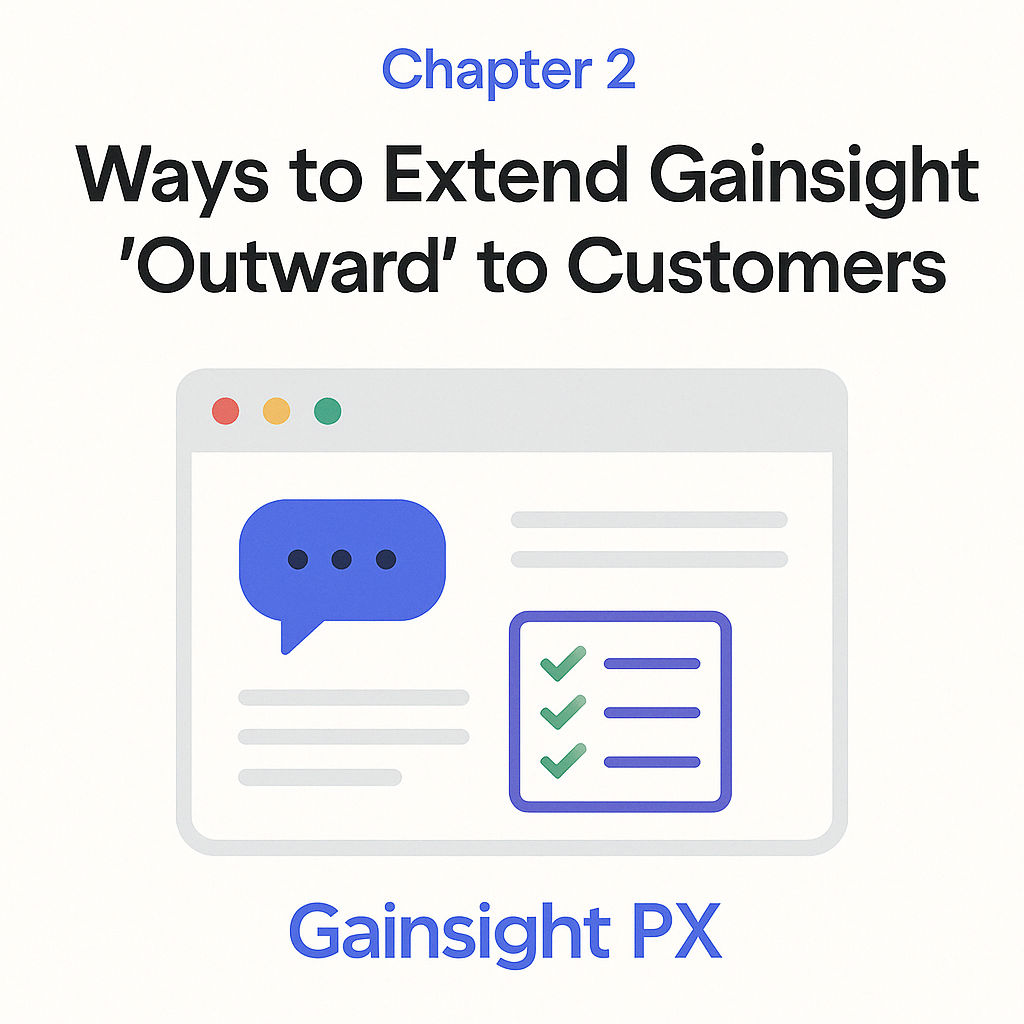
It starts out innocently enough.
Your CSM team has a solid process. There’s a success plan in Gainsight. A few CTAs are triggered. Your CS Ops team has refined usage scoring and automated alerts. Everyone internally feels like things are under control.
But then the customer emails:
“Hey—what’s the status of the implementation?”
“Who’s handling the integration work again?”
“Can you send over a project plan?”
Suddenly, the internal success plan doesn’t feel so successful anymore.
When Customers Are Out of the Loop
This moment reveals a critical truth: internal tools don’t equate to external clarity. Most CSM tools weren’t designed to be shared. And even when you try to share information—via exported PDFs, spreadsheets, or status calls—those efforts are disjointed, manual, and not collaborative.
This creates friction in the relationship:
Misalignment on who’s responsible for what
Confusion about timelines or deliverables
Reduced trust because the customer feels “out of the loop”
Lower NPS due to perceived disorganization or lack of communication
Even the best internal CSM workflow can feel like a black box to your customer.
The Cost of Operating in Silos
This lack of shared visibility doesn't just affect sentiment—it affects outcomes:
Onboarding gets delayed because action items fall through the cracks.
Escalations drag on because no one owns the resolution across teams.
Renewals are put at risk because customers don’t see the value being delivered.
In short, you’re working hard behind the scenes—but without a shared space, your customer doesn’t feel it.
The Need for a Shared Operating Layer
This is why forward-thinking CS leaders are adding customer-facing collaboration platforms like ezRACI to their stack.
Instead of relying solely on internal tools, they’re giving customers real-time visibility and ownership across shared plans. With ezRACI, everyone—on both sides of the relationship—knows:
What’s happening
Who’s doing it
When it’s due
And because ezRACI syncs with your existing CSM tools, you don’t have to duplicate work. It simply becomes the outward-facing layer that transforms static plans into interactive customer journeys.
In the next chapter, we’ll explore how Gainsight (and similar platforms) offer some ways to expose data to customers—but often fall short of true collaboration. That’s where ezRACI shines.
Chapter 3: Where Gainsight Leaves Off—ezRACI Picks Up
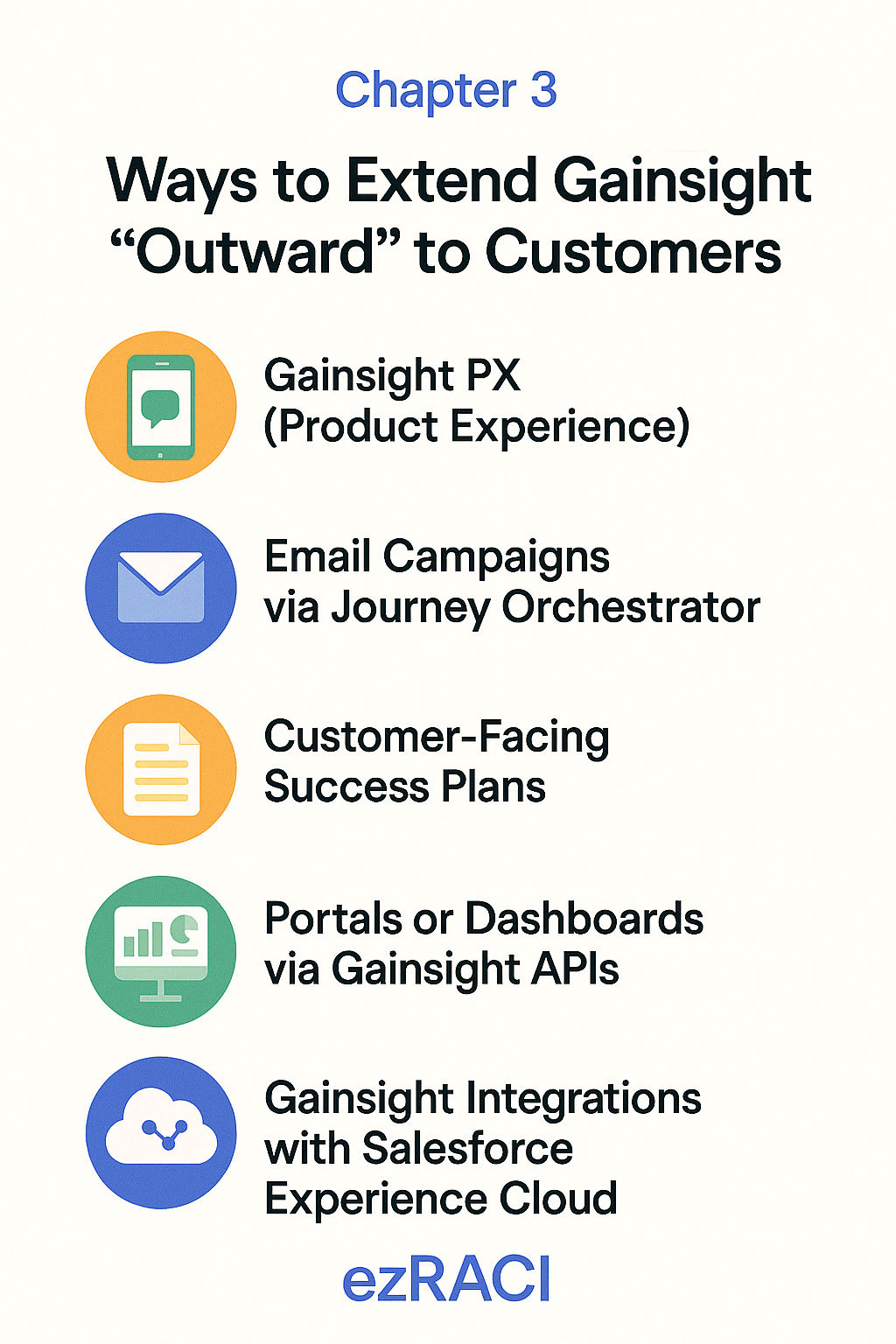
Gainsight is arguably the gold standard in Customer Success software. It enables your CS team to forecast risk, drive adoption, automate outreach, and manage complex accounts at scale. But when it comes to external collaboration with your customers, its capabilities begin to taper off.
To be fair, Gainsight offers several ways to surface internal plans or data to customers—but let’s unpack them honestly.
🚪Option 1: Gainsight PX (Product Experience)
PX gives you the ability to run in-app surveys, onboarding walkthroughs, and feature announcements. This is the most direct, customer-facing capability Gainsight offers.
But PX is not collaborative—it’s a broadcast mechanism. You can tell the customer something. You can collect data. But they can’t work alongside you in PX.
📬Option 2: Journey Orchestrator (Email Campaigns)
Journey Orchestrator allows you to send lifecycle-based email campaigns to customers based on their behavior or phase. Again, this is useful—but one-directional. It’s communication, not collaboration.
There’s no way for the customer to interact with those emails beyond clicking a link or filling out a form. There's no shared sense of progress, no mutual accountability.
📤Option 3: Exporting Success Plans (PDFs, Spreadsheets)
Gainsight’s Success Plans are powerful—but internally focused. If you want to share milestones, objectives, or timelines with your customer, you typically:
Export a PDF or spreadsheet.
Email it.
Hope they read it and understand what’s going on.
No interactivity. No ownership. No updates in real time. You’re sending static documents in a dynamic world.
🛠️Option 4: Build a Custom Portal with Gainsight APIs
Yes, you can build something customer-facing by using Gainsight’s APIs. But doing so requires:
Engineering resources
UX/UI planning
Ongoing maintenance
Budget approval
It’s a viable path—but one that’s complex, expensive, and slow to deliver.
🧩This Is Where ezRACI Changes the Game
ezRACI doesn't replace Gainsight. It complements it by serving as your customer-facing collaboration layer—without code, without custom development, and without needing to retrain your CS team.
Here's how ezRACI transforms the experience:
Sync Gainsight CTAs into an ezRACI board so customers see what’s happening in real time.
Expose Success Plan milestones as editable cards, each with RACI ownership and deadlines visible to everyone involved.
Collaborate in threads linked to specific objectives—where CSMs, customers, and delivery teams can all contribute.
Visualize the entire engagement in a Gantt chart customers actually understand.
Trigger alerts in Slack or MS Teams when progress is made—or when someone is blocked.
This isn’t just visibility—it’s true participation.
Instead of being managed on behalf of the customer, the customer becomes an active participant in their success journey. They feel seen. They feel involved. And they’re much more likely to stick around because of it.
In the next chapter, we’ll explore a critical pain point for CSMs: how to make CTAs more collaborative—and how ezRACI turns those tactical tasks into strategic, shared accountability.
Chapter 4: Making CTAs Collaborative with ezRACI

For many Customer Success teams, Calls-to-Action (CTAs) are the lifeblood of daily operations. Gainsight, Totango, and similar platforms use CTAs to keep CSMs focused, prompt proactive engagement, and ensure nothing falls through the cracks.
But let’s be clear: CTAs are built for internal execution.
They tell your CSMs what to do and when.
They often contain rich context—usage alerts, health score drops, playbook instructions.
They keep your team in sync.
But they do not keep your customers in the loop.
The CTA Breakdown: What the Customer Doesn’t See
Imagine this: a critical CTA is triggered in Gainsight to follow up on a delayed integration. The CSM gets the notification, reviews the playbook, and begins outreach. But on the customer side:
They don’t see the task.
They don’t know who owns what.
They don’t understand the urgency.
The CTA might be crystal clear inside your CSM platform—but from the customer’s perspective, it’s invisible. This is a recipe for frustration, misalignment, and dropped balls.
Turning CTAs into Shared Tasks with ezRACI
Now imagine a different scenario—one where Gainsight’s internal CTA syncs to an ezRACI board, shared between your team and the customer.
Suddenly:
The CTA becomes a visible task card, assigned with RACI clarity.
The customer sees who’s Responsible, Accountable, Consulted, and Informed.
Comments, updates, and progress are tracked in real time.
Deadlines are visible on a Gantt chart, creating mutual understanding.
Stakeholders receive updates via Slack or MS Teams the moment something changes.
Now you’ve taken an internal trigger and turned it into shared momentum.
Example: Onboarding Integration CTA
Without ezRACI:
Internal CTA fires: “Follow up on integration kickoff.”
CSM emails the customer: “Hey, where do we stand?”
Customer responds two days later: “Let me check with my dev team.”
With ezRACI:
Internal CTA fires → synced to ezRACI.
Shared task appears: “Finalize Integration Timeline”
Responsible: Customer Dev Lead
Accountable: CSM
Consulted: Solution Architect
Informed: VP of Customer Success
Timeline is visible on the customer’s Gantt chart.
Status updates tracked collaboratively.
You’ve shifted from chasing the customer to empowering them to own their part of the journey.
Bridging Systems Without Duplication
The best part? ezRACI doesn’t ask your team to abandon Gainsight or duplicate work. It extends your CTA model outward, creating a bridge between what’s happening internally and what the customer sees.
Gainsight remains your system of record.
ezRACI becomes your system of engagement—with the customer.
This approach not only boosts accountability and visibility, but it also builds trust. Customers no longer feel like they’re guessing what’s going on—they’re part of the process.
In the next chapter, we’ll zoom out from individual CTAs and look at how Success Plans can evolve from static documents into real-time, collaborative strategies using ezRACI.
Chapter 5: Real-Time Success Planning with ezRACI
Success Plans are the strategic backbone of Customer Success. Whether you’re using Gainsight, ZeroChurn, or Totango, these plans typically include:
Key milestones
Objectives and goals
Risks and mitigation steps
Owner assignments
Timelines
They’re built to align internal teams on the long-term vision for an account. But once again, we run into a familiar problem:
👉 Success Plans are rarely collaborative with the customer.
The Static Nature of Success Plans
In most CS platforms, Success Plans are:
Visible only to internal teams
Difficult to export in a meaningful way
Manually shared (via PDFs or spreadsheets)
Not actionable or interactive for customers
Even when you send a copy over, customers can’t update it, comment on tasks, or track progress in real time. And when plans change—which they always do—your shared version is already outdated.
This static, one-way sharing method breaks the very thing Success Plans are supposed to foster: alignment.
ezRACI: Where Success Planning Becomes Dynamic and Shared
With ezRACI, Success Plans become living, breathing collaboration tools. Here's how:
🔄 Real-Time Updates
Instead of sending documents back and forth, ezRACI syncs success plan elements into a shared workspace where updates happen collaboratively.
Milestones and objectives are tracked in an interactive board.
Each item has real-time status, owner, and due date.
Changes are instantly visible to both internal and external stakeholders.
👥 Role-Based Clarity
Each milestone is supported by a RACI assignment—so everyone involved knows who’s doing what:
Responsible: Executes the task.
Accountable: Owns the outcome.
Consulted: Provides input.
Informed: Needs to stay in the loop.
This eliminates the common “Who’s owning this?” confusion that derails timelines and erodes trust.
📈 Gantt Charts for Timeline Visualization
Success Plans aren’t just lists—they’re strategic journeys. ezRACI turns milestones into visually intuitive Gantt charts, allowing:
Both teams to understand dependencies
Easy identification of bottlenecks
A shared, time-based roadmap that updates automatically
💬 Embedded Comments and Threads
Every success plan milestone in ezRACI supports conversational context—so CSMs, customers, and technical teams can:
Ask questions
Share updates
Link documents
Surface blockers in real time
This transforms the plan from a static document into a central nervous system for collaboration.
Example: QBR Readiness Plan
Traditional Approach:
CSM creates internal QBR checklist in Gainsight
Sends a one-pager to the customer a week before the call
Customer scrambles to review it or asks for a new version
With ezRACI:
Shared QBR plan is visible in ezRACI weeks in advance
Each section is owned by a stakeholder with clear RACI roles
Timeline is transparent; updates and commentary are ongoing
Everyone shows up to the QBR aligned and prepared
A Strategic Advantage
By turning Success Plans into collaborative blueprints, ezRACI gives you a strategic edge:
Better execution of value delivery
More engaged customers
Stronger relationships built on transparency and shared accountability
Success becomes something you do together, not something you deliver alone.
Next, we’ll zoom in on one of ezRACI’s core superpowers: the RACI Matrix—and how it helps eliminate ambiguity across even the most complex CS engagements.
Chapter 6: RACI Matrix — Role Clarity at Scale
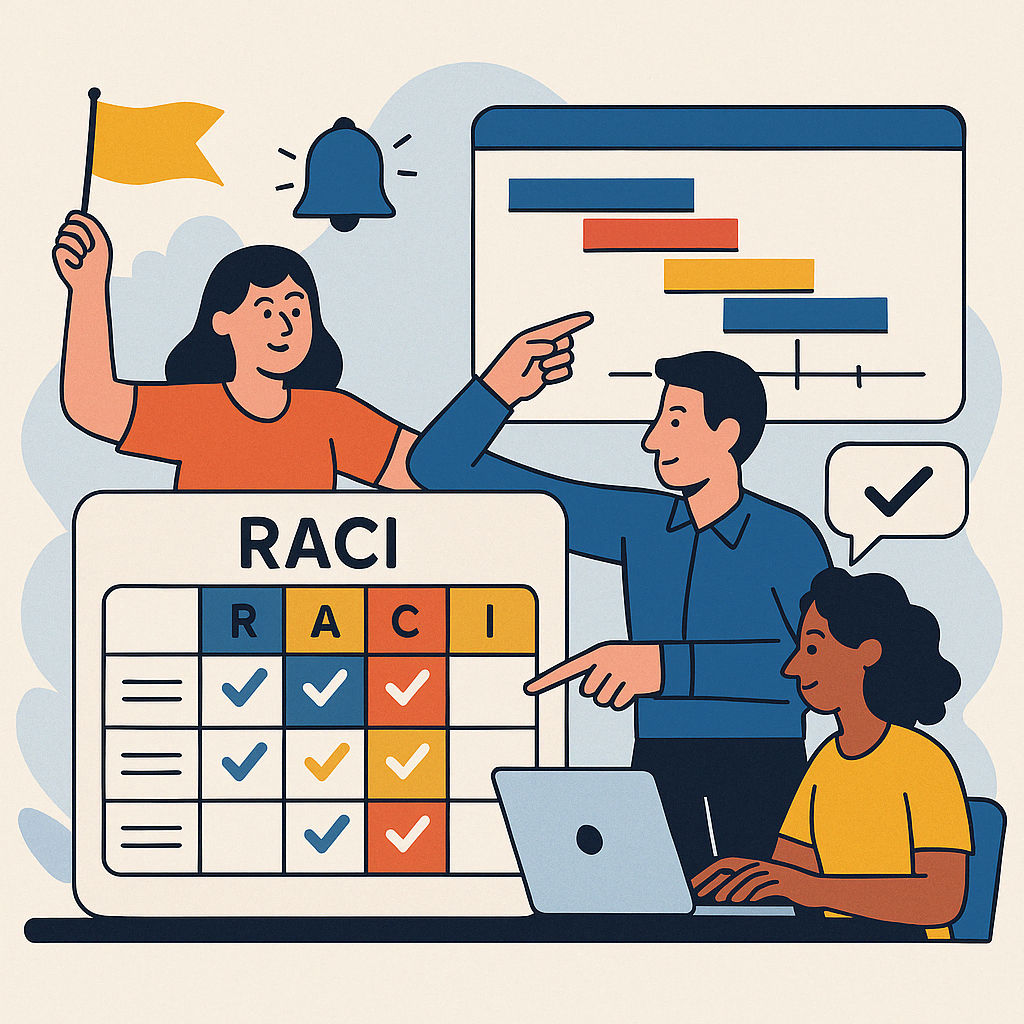
One of the most common reasons customer projects stall isn’t a lack of effort—it’s a lack of clarity.
You’ve probably seen it:
Tasks that linger because “I thought they were doing it.”
Customers unsure of who to contact on your side.
Internal teams waiting on a customer who thought you were responsible.
These gaps don’t stem from bad intentions. They stem from role ambiguity—and it’s a silent killer of momentum.
Why Role Clarity Matters More Than Ever
In today’s complex B2B environments, every customer initiative touches multiple stakeholders:
Customer stakeholders: technical leads, champions, executive sponsors, procurement.
Your team: CSMs, solution architects, support, renewals managers, onboarding teams.
Without a clear understanding of who’s doing what, friction builds fast. Deadlines slip. Communication slows. The customer experience suffers.
Enter the RACI Matrix
RACI is a time-tested model that simplifies responsibility:
R = Responsible (Does the work)
A = Accountable (Owns the outcome)
C = Consulted (Provides input)
I = Informed (Needs updates)
The beauty of RACI is its simplicity. The power of ezRACI is how it makes this clarity operational and collaborative.
How ezRACI Elevates RACI
Rather than using a RACI chart buried in a slide deck or spreadsheet, ezRACI embeds role clarity into the daily workflow of both internal and customer teams:
✅ Every Task Has RACI Assignments
From onboarding tasks to escalation resolutions, each card in ezRACI has assigned roles that are clearly visible to all collaborators.
No more guessing who’s accountable.
No more duplicated efforts.
No more “I didn’t know that was on me.”
🔁 Role Ownership Scales with Templates
Whether you're managing:
50 onboarding projects,
25 escalations, or
10 renewals…
…you can use pre-built ezRACI templates with default RACI assignments that auto-fill based on the context. This ensures consistency without reinventing the wheel every time.
📊 Visibility Across the Organization
Because ezRACI integrates with tools like Slack, MS Teams, and even your CSM platform (like Gainsight or Totango), stakeholders are kept in the loop automatically—based on their RACI designation.
“Informed” stakeholders get relevant notifications.
“Consulted” participants are looped in at the right moment.
“Accountable” parties receive deadline reminders.
It’s operationalized clarity—not just theory on a slide.
Use Case: Escalation Management
Let’s say a major customer has a security integration issue. The CS org pulls in technical support, product, and the customer’s own IT lead.
Without RACI:
Support waits on product.
Product doesn’t know it’s their ticket.
The customer is emailing everyone and getting no clear answer.
With ezRACI:
One shared card defines the escalation path:
Responsible: Customer’s DevOps lead
Accountable: CSM
Consulted: Product Engineer
Informed: VP of Customer Success
Everyone knows what’s happening, who’s doing it, and how it’s progressing.
Role Clarity = Faster Outcomes + Higher Satisfaction
By embedding RACI directly into the day-to-day customer experience, ezRACI helps you:
Accelerate onboarding and issue resolution
Avoid costly miscommunications
Improve customer satisfaction and NPS
Drive real accountability across both sides of the partnership
In the next chapter, we’ll take role clarity one step further—by adding the element of time. Let’s look at how Gantt charts in ezRACI help internal and external teams stay aligned on project timelines, dependencies, and milestones.
Chapter 7: Visual Timelines They’ll Actually Use

You’ve got your Success Plan. Tasks are assigned with crystal-clear RACI roles. Everyone knows their part. But there’s still one question looming:
“When is all of this happening?”
Without a clear, visual timeline, even the most organized plans can become overwhelming or misunderstood—especially for customers who aren’t living inside your CS tools.
That’s where ezRACI’s Gantt chart visualizations come into play.
The Problem with Static Timelines
Traditional CSM tools often manage timelines in a way that’s either:
Buried within internal fields and reports (inaccessible to the customer)
Static, via exported spreadsheets or presentation decks
Manually updated, which leads to out-of-date plans
And if you’re using project management tools like Smartsheet, MS Project, or Monday.com, you might end up duplicating work or losing the connection between project activity and the success plan strategy.
Customers are left guessing:
What’s happening this week?
Are we behind on anything?
What’s coming up next?
ezRACI Gantt Charts: Shared, Real-Time, and Intuitive
With ezRACI, timelines aren’t just internal—they’re shared and dynamic, offering both your team and the customer a unified view of what’s happening and when.
📅 Visualize Milestones Across the Relationship
Every task and milestone in your Success Plan appears in a collaborative Gantt chart:
Easy drag-and-drop adjustments
Clearly marked dependencies
Color-coded by status
Synced in real time with task progress
Whether it’s a multi-week onboarding project or a fast-moving renewal plan, the Gantt view becomes your shared command center.
🔄 No More Manual Updates or Slide Decks
Instead of scrambling to update PowerPoint timelines before every QBR, ezRACI gives you a living timeline:
Updated automatically as tasks progress
Instantly reflects changes in priority or scheduling
Visible to all RACI stakeholders
The result? Everyone stays aligned—and prepared.
👀 Customers Actually Use It
ezRACI’s timelines are built for collaboration, not complexity:
Customers can view timelines without needing training
Comments and questions can be posted directly on milestones
Notifications are sent when due dates shift or blockers arise
This makes your timeline interactive, not just a picture in a deck.
Example: Go-Live Project Visualization
Without ezRACI:
The project plan is managed in a PM tool
A PDF timeline is sent before each meeting
The customer doesn’t know what’s changed until the call
With ezRACI:
Customer logs into their shared board anytime
Sees the entire Go-Live timeline in a Gantt chart
Knows immediately what’s completed, what’s in progress, and what’s next
Can ask questions or flag blockers without waiting for a status meeting
Why This Matters
Time is one of the most valuable assets in any customer engagement. By showing your customers how their time is being spent—visually and transparently—you:
Build trust
Increase accountability
Reduce surprises
Keep momentum alive
In a world where timelines can slip silently, ezRACI turns time into a shared asset.
Next up, we’ll explore how ezRACI keeps everyone in sync across daily workflows—with automated Slack and MS Teams alerts tied directly to Gainsight CTAs and ezRACI tasks.
Chapter 8: Automating Communication via Slack/MS Teams
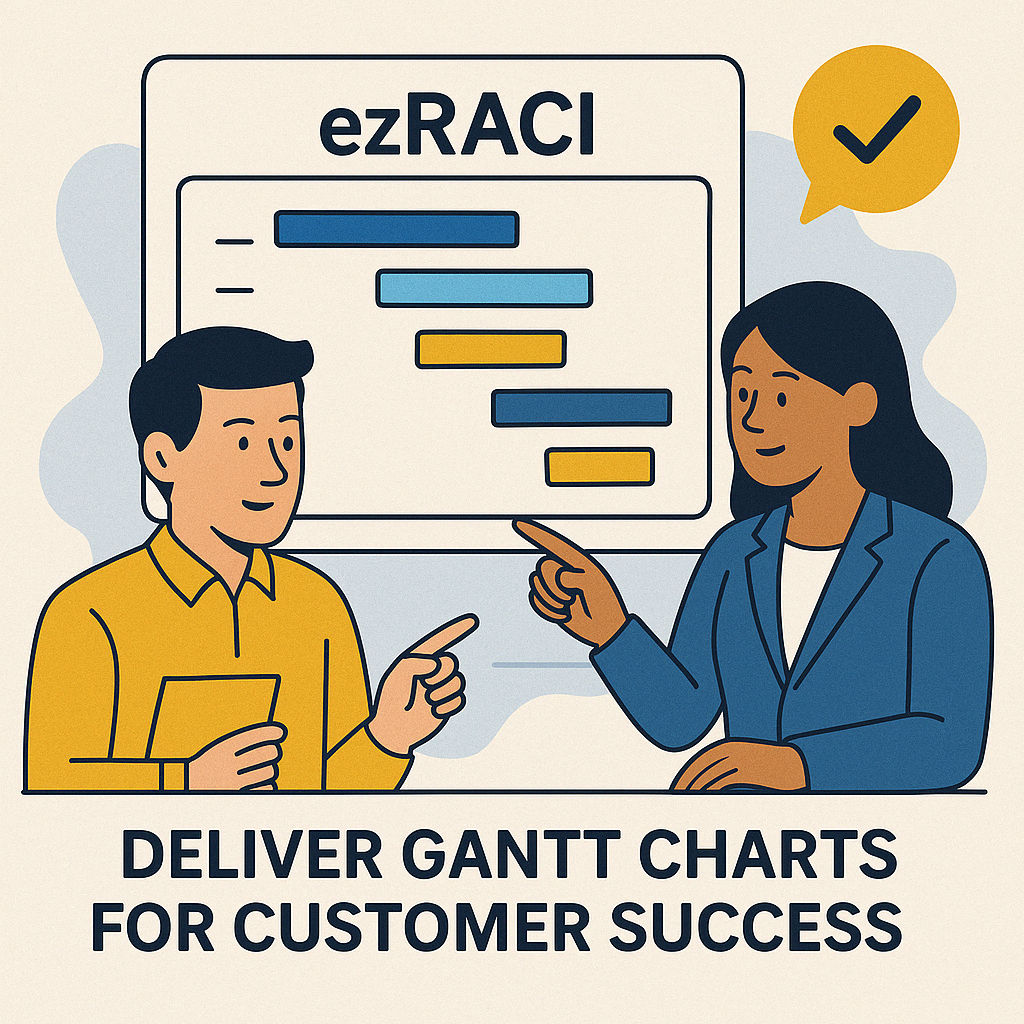
If you’ve ever sat in a customer status call and asked, “Did you see the update I sent?”—this chapter is for you.
One of the biggest challenges in managing complex customer engagements isn’t planning—it’s staying aligned in real time. Even with great tools like Gainsight and clear plans in place, updates often get lost in inboxes or buried in project portals no one checks daily.
Your customers and internal teams live in Slack and Microsoft Teams. That’s where collaboration happens. And that’s exactly where ezRACI brings your customer success plans to life—with real-time, context-aware notifications.
The Communication Gap in Traditional CSM Tools
Most CSM platforms are built for dashboards, not day-to-day chatter. Even when a task is overdue or a milestone is missed:
Internal teams don’t always get the update unless they log in.
Customers rarely have access to the platform at all.
Status changes live in silence until someone manually escalates.
That’s a recipe for reactive firefighting—not proactive success.
ezRACI Bridges That Gap with Smart, Connected Alerts
With ezRACI, communication becomes automated, targeted, and native to where work happens.
💬 Slack/MS Teams Integration
Every action in ezRACI—whether triggered directly or synced from Gainsight—can notify stakeholders in Slack or Teams channels based on RACI role:
Responsible: Gets pinged when a deadline is approaching
Accountable: Notified when a blocker is flagged
Consulted: Included in a thread when input is needed
Informed: Sent a summary when milestones shift
These aren’t generic “update emails.” They’re real-time nudges, delivered in tools your team and customers actually use.
🔁 Live Sync with Gainsight CTAs
Here’s where it gets really powerful: when a Gainsight CTA is created or updated, ezRACI can:
Sync the CTA to a shared ezRACI board
Automatically assign RACI roles
Trigger Slack or Teams notifications to involved parties
Now, a CTA isn’t just a task in your CSM tool—it becomes an actionable, collaborative, and visible item across both internal and customer teams.
🧠 Intelligent Alerts That Respect Attention
You can fine-tune alert preferences in ezRACI to avoid overwhelming your team or customers:
Only notify on overdue or at-risk items
Send summaries instead of individual updates
Use custom channel mapping by account or phase
It’s designed to enhance focus, not add noise.
Example: Escalation Alert Flow
Without ezRACI:
A critical CTA is assigned in Gainsight.
The CSM follows up by email—no response.
Days pass, the issue escalates.
The customer says, “We didn’t know it was that urgent.”
With ezRACI:
The CTA syncs to ezRACI and tags stakeholders.
Slack alert goes to the internal #cs-urgent channel.
Teams alert goes to the customer’s #integration-support room.
Everyone sees the issue, assigned roles, and due date—within minutes.
Results: Faster Action, Fewer Meetings
By bringing your customer success plans into Slack and Teams:
Updates happen in real time
Less reliance on status meetings and emails
Increased engagement from both internal and external teams
Fewer missed deadlines and dropped tasks
Communication stops being a bottleneck—and starts being a strategic enabler.
Next, we’ll look at how to scale this model with templated success frameworks in ezRACI that customers can actually interact with—boosting consistency, speed, and trust.
Chapter 9: Templatize Success—And Let Customers See It
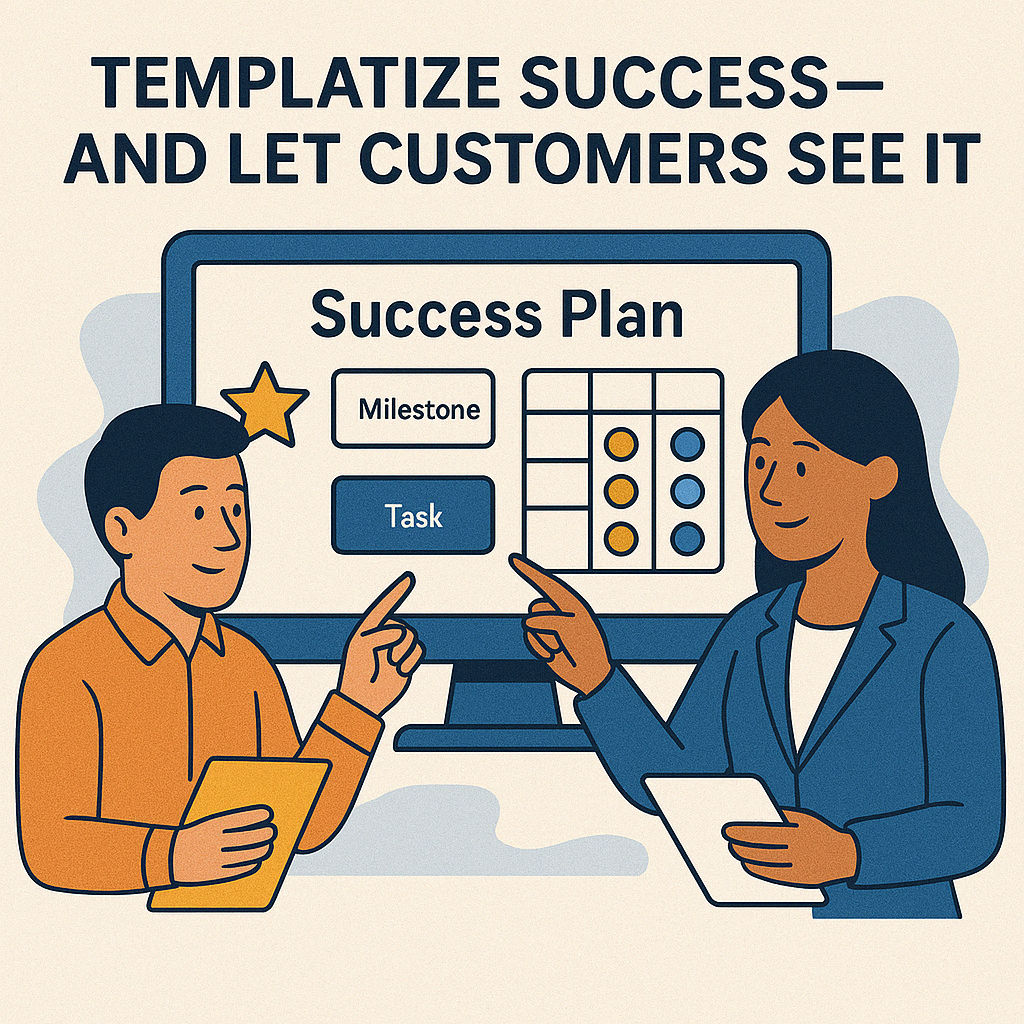
One of the most powerful ways to scale Customer Success is through repeatable frameworks. That’s why platforms like Gainsight, ZeroChurn, and Totango encourage the use of playbooks, journey maps, and lifecycle models.
But there’s a major problem with how most teams use templates today:
They’re internal only.
Customers rarely see the structured process that guides their journey. They don’t know what’s coming next, who owns what, or how progress will be measured—unless someone takes the time to explain it manually.
This creates friction, confusion, and missed opportunities to build trust.
ezRACI Turns Internal Playbooks into Shared, Interactive Experiences
With ezRACI, your success templates don’t just live in the background. They become visible, collaborative roadmaps that both you and your customer can follow—together.
📋 Cloneable Templates for Every CS Moment
Whether you’re onboarding a new customer, managing a high-risk escalation, or preparing for renewal, ezRACI lets you create pre-built project templates with:
Pre-defined milestones and tasks
Built-in RACI assignments
Standard timelines
Discussion prompts
Gantt chart layouts
These templates can be cloned, customized, and shared with the customer—so your internal consistency becomes their external confidence.
👥 Customers See the Game Plan
Instead of getting a vague status update or a summary email, your customer can log into their ezRACI board and see:
The full journey laid out ahead of them
Who’s doing what, and when
What they need to complete next
How their engagement compares to others (if you choose to benchmark)
This gives them a sense of control, ownership, and predictability.
🔄 Real-Time Adjustments
Templates in ezRACI aren’t rigid. You can:
Adjust timelines based on customer speed
Add or remove milestones as needed
Reassign ownership if stakeholders change
Keep everything visible without breaking the original framework
This keeps your CS motions structured but flexible—adaptable to the nuance of each customer without sacrificing consistency.
Example: Enterprise Onboarding Template
Without ezRACI:
Your team uses an internal onboarding playbook in Gainsight
The customer sees only what’s shared in weekly emails or kickoff slides
Miscommunication arises around who’s responsible for provisioning or UAT
With ezRACI:
You clone the “Enterprise Onboarding” template into the customer’s board
Milestones like “Environment Setup,” “User Training,” and “UAT Sign-Off” are already populated with RACI roles and deadlines
The customer team knows exactly what to expect and when to deliver
Progress is tracked collaboratively and updated in real time
Scale Without Losing the Human Touch
The best part about templatizing with ezRACI is that it enables repeatable excellence while maintaining personalized delivery:
No more reinventing processes
No more buried tribal knowledge
No more guesswork for the customer
You deliver faster, with fewer handoffs and hiccups—and the customer feels like they’re on a professional, well-oiled journey every step of the way.
In the final chapter, we’ll bring it all together—showing how Gainsight and other CSM tools remain your internal system of record, while ezRACI becomes the outward-facing system of execution that delivers clarity, collaboration, and results.
Chapter 10: The Unified Source of Truth—Together
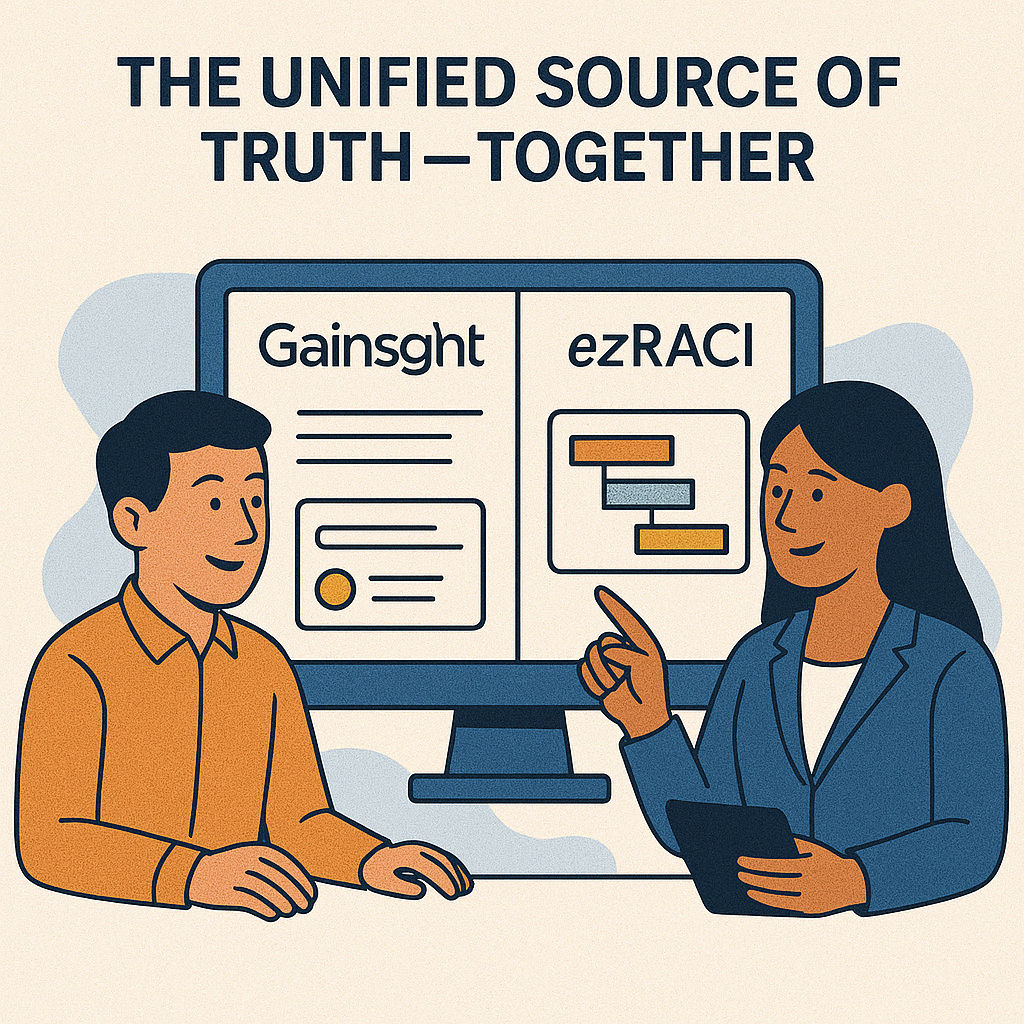
Throughout this guide, we’ve seen how tools like Gainsight, ZeroChurn, and Totango offer world-class internal capabilities for Customer Success:
Health scoring
Playbook automation
Success Plans
CTA management
Usage analytics
These platforms are powerful—but they were never meant to be collaborative customer workspaces.
That’s where ezRACI steps in—not as a replacement, but as a powerful extension that makes your CS strategy visible, collaborative, and real-time for your customers.
🔄 Internal + External = Full-Circle Success
Let’s make one thing clear:
Gainsight is your internal system of record.
ezRACI becomes your customer-facing system of execution.
When paired together, they create a closed loop:
Strategy and structure live in Gainsight (playbooks, CTAs, plans).
Execution and engagement happen in ezRACI (shared tasks, timelines, and ownership).
Updates and outcomes flow back into Gainsight for reporting and optimization.
It’s a continuous cycle—one that brings internal precision and external collaboration into harmony.
🔧 The ezRACI Integration Flywheel
Gainsight CTA fires → ezRACI syncs it to a shared board with RACI clarity.
Success Plan milestones → mapped to Gantt charts the customer can track.
Task progress and blockers → discussed in real-time via ezRACI + Slack/MS Teams.
Outcome data → can be pushed back to Gainsight (via API) for reporting.
Now, everyone’s aligned—no more black boxes or side conversations.
💼 A Better Customer Experience = A Stronger CS Team
When you extend your CSM tools outward through ezRACI:
Customers gain confidence in your process.
Internal teams gain clarity on responsibilities.
Engagement becomes ongoing, not episodic.
CS leadership gains visibility into collaboration health.
You create a differentiated experience—one where customers aren’t just managed, they’re included. Not just supported, but empowered.
Final Thought: Don't Just Manage Customers—Build With Them
In today’s B2B landscape, customers expect more than communication—they expect collaboration. Static documents and one-way updates won’t cut it anymore.
The future of Customer Success lies in shared workspaces, shared timelines, and shared accountability.
ezRACI delivers that future—right now.
Pair it with your existing tools like Gainsight or Totango, and you won’t just run Customer Success. You’ll transform it into a customer-powered engine of value, trust, and growth.
